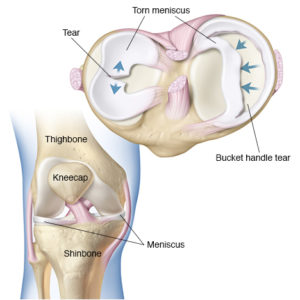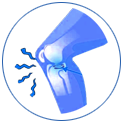The knee joint is the commonest joint to be injured with playing sports, the bones of the knee are covered with cartilage to allow smooth movement. There is medial & lateral meniscus (cushions) – that function as shock absorbers. It has two internal cruciate ligaments (ACL & PCL) and two external collateral ligament (MCL & LCL) that provide stability.
Severe injuries to the knee joint requires a review from a Orthopedic Knee specialist to ascertain early and accurate diagnosis of the injury and initiation of early treatment. Dr Gautam Tawari is a UK fellowship trained Orthopedic Doctor and a Royal college of Orthopedic surgeons accredited Sports and Knee arthroscopy surgeon in mumbai. He undertakes arthroscopic ACL/PCL surgery, Meniscal repairs, Knee Cartilage surgery and Stem cell treatment in the knee joint.
He follows an advanced rehabilitation protocol to ascertain his patients get back to sports quicker and more confidently.
Menisci are two C-shape cartilage pieces present inside the knee joint, often referred as cushions. They stabilise the knee joint and act as “shock absorbers”. Meniscus tear is the commonest knee injury in athletes, especially those involved in contact sports. A sudden bend or twist of the knee cause the meniscus to tear. Elderly people are more prone to degenerative meniscal tears as the meniscal tissue wears out and weakens with age.

Presentation
Torn meniscus causes pain, swelling, stiffness, catching or locking sensation of the knee. The knee is unable to move through its complete range of motion.
Treatment
The treatment depends on the type, size and location of tear as well as age and activity level of the patient. Knee arthroscopy is often required for meniscal tears. Surgery is performed using arthroscope (pencil like camera) which enables to visualise and treatment is carried out with special instruments.
The arthroscopic treatment options include excision of damaged part of meniscus (partial meniscectomy), meniscus repair or meniscus replacement. During meniscectomy, small instruments called shavers or scissors may be used to remove the torn meniscus. In arthroscopic meniscus repair the torn meniscus is pinned or sutured to its rim.
Meniscus replacement or transplantation involves replacement of a torn cartilage with the cartilage obtained from a donor or a cultured patch obtained from laboratory. It is considered as a treatment option in very young patients with loss of meniscus.
As per Gautam Tawari – one of the premier knee surgeon in Mumbai, knee arthroscopy is an advanced, minimally invasive surgical procedure where doctors can look inside the knee of a patient, carry out the necessary treatment without making large incisions.
Procedure
As per Dr Gautam Tawari – the best knee surgeon in Navi Mumbai, the procedure begins when the surgeon inserts a small camera known in the medical community as, an arthroscope into the target area.
The role of this equipment is to offer the surgeon with real-time footage of everything that is going on inside the target area of your knee on a monitor so that the surgeon can make the necessary adjustments to your knee using miniature yet precise surgical instruments.
When this treatment is needed?
According to Dr Gautam Tawari – one of the leading knee surgeon in Navi Mumbai, this treatment is often prescribed by a doctor when the patient has constant pain in his or her knee – a condition that doesn’t seem to come under control even the patient has been subjected to all possible nonsurgical treatments such as rest, physical therapy, and medications.
Knee arthroscopy, Cartilage Treatments are some of the treatments that are often prescribed to patients who have been diagnosed with issues related to their knees, the cartilage surround them as well as the ones who have sustained knee sports injuries
Are there any risks?
Any total knee replacement surgery performed comes with its fair share of risks and knee arthroscopy is no exception. With that stated, possible risks associated with this treatment are as follows –
- Infection
- Blood clots
- Knee stiffness
- Accumulation of blood in the knee
What is the time needed to recover after knee arthroscopy?
Dr Gautam Tawari – the best knee surgeon in Mumbai states that after surgery, the patient will be shifted to a recovery room where he or she would need to rest for at least 1 to 2 hours. After this, the patient can go back home but one would need to make sure that they are following the directions of their doctor to the dot!
